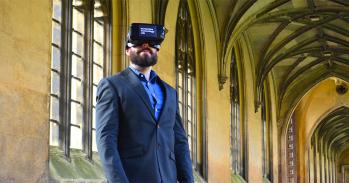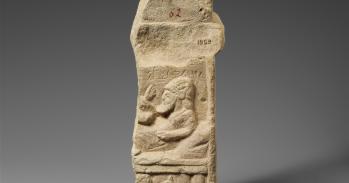
A new guide calls for a broader approach to teaching Latin, one that draws on modern languages education, involving speaking, music and storytelling.
A new guide calls for a broader approach to teaching Latin, one that draws on modern languages education, involving speaking, music and storytelling.
Falling uptake means there is now a moral imperative for us to be open to different ideas
Steven Hunt
Fan fiction, Minecraft and Taylor Swift lyrics are hardly the stuff of traditional Latin lessons. They are, however, part of an expanding repertoire that teachers are successfully drawing on to deepen students’ grasp of the language of Virgil and Cicero.
All three are cited – alongside many other examples of innovative tools and techniques – in a new handbook which calls for a rethink about how to teach Latin. Its author, the Cambridge academic Steven Hunt, suggests that mainstream teaching practices, some of which date back to the 1950s, are linked to dwindling uptake in the subject and that change is overdue.
Part of his suggested solution is for Classics teachers to follow the lead of subjects like French and German, where students learn to use and communicate in their target language. Hunt argues that students would comprehend Latin better if they were exposed to opportunities to speak, sing, perform or write creatively in it, rather than just learning vocab and grammar, and translating set texts. They might also enjoy it more.
His book shows that some more adventurous teachers are, indeed, already following this path and innovating in the classroom to engage students and improve fluency. While Hunt does not dispute the value of some traditional teaching methods, he does suggest that a more open-minded approach to how Latin might be taught, drawing on the evidence from other language subjects, would help students to thrive.
Hunt has been a Latin teacher for 35 years, and now trains teachers on the University of Cambridge PGCE. “The trouble with Latin teaching is that it’s never been subject to thorough academic investigation; we tend to rely on anecdotal information about what seems to work,” he said.
“There is no ‘best way’ to teach it, but some teachers are creating a rich set of responses to the challenge. Most draw on principles from modern languages education. Because the human brain is hardwired for sound, it learns by speaking, listening and using language. Some Latin teachers are realising that this is the way to learn any language – dead or alive.”
Hunt believes that many students are disengaged by the standard teaching model for Latin: an outdated formula focused on vocab, grammar, translations, comprehension exercises and rote-learning. There is little evidence from research in modern languages that this is the best way to develop students’ fluency or understanding, and there has been a steady decline in the numbers of students choosing Latin for examination. “Falling uptake means there is now a moral imperative for us to be open to different ideas,” he said.
His book makes a case for more forms of ‘active’ Latin – encouraging students to use and communicate in the language. One argument is that of ‘communicative necessity’. Speaking a language means students have to make themselves understood in real time, so they often grasp core principles, and learn to correct mistakes, quickly. Similarly, he advocates giving students more opportunities to hear Latin being sung or spoken. This can, for example, embed vocabulary in the long-term memory: when we recall a word, what we are really recalling is its sound.
The book also suggests new ways to develop the traditionally favoured skills of reading and translation. For example, some teachers have successfully improved students’ ability to master complicated texts, like Cicero’s speeches, through a process called ‘tiering’, in which they start with simplified versions and gradually build up to reading the full, complex original.
Evidence is also emerging, particularly from the US, that free composition – creative writing in Latin – can improve fluency, translation, and deepen students’ appreciation of Roman authors. In some classrooms, students now produce poetry, prose and songs in Latin, as well as their own fan fiction – which often involves tributes to characters from popular programmes such as the Cambridge Latin Course.
One example cited in the book comes from a university tutor who, having struggled to develop his students’ understanding of Virgil’s poetry, asked them to try translating well-known songs instead. In a research paper, he describes how, for instance, students Latinised the chorus of Taylor Swift’s Bad Blood: Quod, care, nunc malum sanguinem habemus. He found their choices about how to translate the hits strengthened their ability to “recognise, comprehend and use” different techniques in Roman poetry. The exercise is now a staple of his Latin Prose Composition course.
Similar examples of innovative practice abound in Hunt’s book. Adopting principles from language immersion, many teachers use techniques such as storytelling, singing and dramatic performances to get students using Latin, while some universities now have Latin-speaking social circles.
Teachers are also producing their own resources to support these endeavours. A thriving culture of self-published Latin short stories and novellas is encouraging students’ free reading, which according to one study is up to six times more efficient than traditional teaching at building vocabulary.
Elsewhere, one enthusiast has recorded Latinised Disney songs, enabling listeners to hear how Let It Go might have sounded had Frozen been made in Ancient Rome. 3D digital modelling and Google Earth are also being used to create opportunities for students to use Latin during virtual walk-throughs of ancient sites; these include a 3D model of Rome built in Minecraft.
Such innovations should, Hunt says, be treated selectively but seriously; while the change they are instigating ought to be welcomed. “Latin’s role as the gatekeeper to an elite education is over, but involving more students, especially in state schools, remains a problem,” he said. “The challenge for teachers in the years to come will be whether they are prepared to grasp these opportunities to present the subject differently, and widen the appeal for students, or whether they prefer to stick to familiar routines.”

The text in this work is licensed under a Creative Commons Attribution 4.0 International License. Images, including our videos, are Copyright ©University of Cambridge and licensors/contributors as identified. All rights reserved. We make our image and video content available in a number of ways – as here, on our main website under its Terms and conditions, and on a range of channels including social media that permit your use and sharing of our content under their respective Terms.




